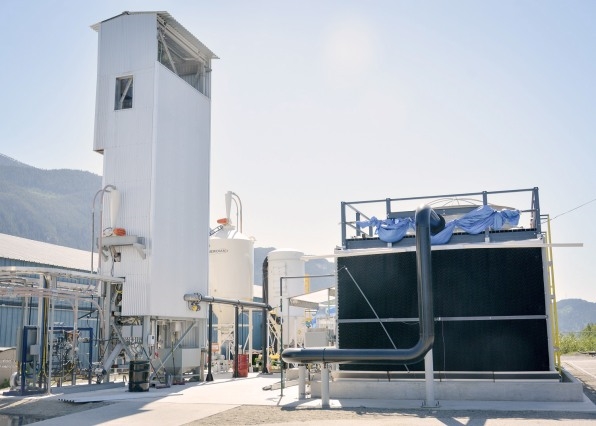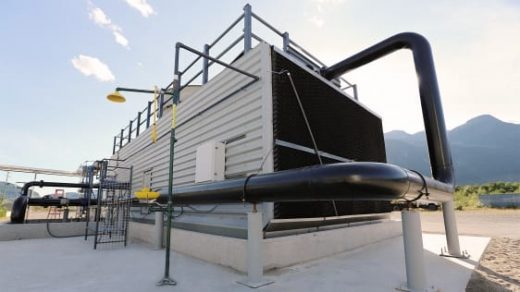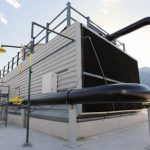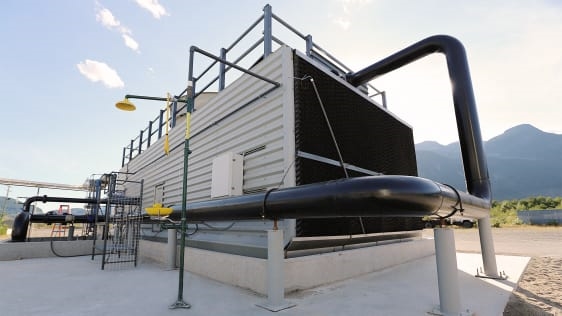Can We Suck Enough CO2 From The Air To Save The Climate?
If humans stopped emitting greenhouse gases tomorrow, we’d still have a problem: Since the industrial revolution, fossil fuels and industry have already emitted more than 1.5 trillion tons of carbon dioxide; another 600 billion tons have come from changing land use. In April, the concentration of CO2 in the air went over 410 parts per million. The last time the concentration was this high–likely during the Pliocene era, when mastodons roamed North America–humans didn’t exist.
As the heat-trapping gases in the atmosphere have grown, so has the global temperature, triggering droughts, wildfires, flooding, and other extreme weather. To have any chance of avoiding catastrophic climate change, some climate researchers say, we’ll need to continue shifting to solar power and electric cars–but we’ll also likely need to use technology to begin sucking large quantities of carbon dioxide directly from the air. Trees alone probably can’t do the job. It poses a question: Can the fledgling “direct air capture” industry scale up quickly enough?
The first commercial plant to pull carbon dioxide from the air opened in Switzerland in May 2017, collecting CO2 that it currently sells to a nearby greenhouse to help plants grow faster. The same startup, Climeworks, opened a second plant in Iceland in October, injecting the CO2 underground, where it can be permanently stored in rocks. Global Thermostat, based in New York, is currently building its first commercial units, which will begin pulling carbon dioxide from the air in 2018. In December, Canada-based Carbon Engineering demonstrated that it could use CO2 pulled from the air to make carbon-neutral fuel; the company is currently raising funds for a larger demonstration plant that it will test for a few years before it begins selling or licensing its technology.

But there are only a handful of companies, and to pull enough carbon dioxide from the air to attempt to preserve a safe climate, we may need, by one estimate, tens of millions of shipping-container-sized units similar to the one now in use in Switzerland.
“There aren’t many companies out there,” says Matt Lucas, associate director for carbon capture, utilization, and sequestration at the Center for Carbon Removal, an organization that supports the industry. “This is not like energy efficiency, where the technology is understood but business models and financing are lacking. Rather, this is something that’s stuck in universities and labs right now, and we need to pull out of the ivory tower and into the market.”
Because the technology is in a very early stage, the cost of the final product–CO2 that could be used to make fuel, or sneakers, or soda–still needs to come down. Climeworks’ first plant produces carbon dioxide that costs $600 a ton. To be truly competitive with other sources of carbon dioxide, it might need to be as low as $60 a ton. But it’s likely that the cost of even the most expensive versions of the technology will quickly drop, as it has in other industries in the renewable sector.
“These are very early, rough prototypes,” says Klaus Lackner, a researcher who pioneered the technology and is director of the Center for Negative Carbon Emissions at Arizona State University. “If you look at photovoltaics [used in solar power], it has come down basically 100-fold since its inception. Wind energy is probably 40-50 times cheaper than it was when it started. So technologies, as they’re maturing and mass-produced, have a track record of getting significantly cheaper. I think the challenge to get from $600 to $60 is not that hard, and it’s actually far less than other technologies have done.”
Global Thermostat, the New York-based startup that will begin operating its first commercial plant in 2018, says that its cost is already far less than competitors. One part of its patented design makes its equipment collect around three times as much CO2 with the same amount of material; another innovation makes it possible to collect the CO2 that it absorbs without using as much energy as other machines.
“Once you get onto a learning curve and start increasing capacity, costs start to drop,” says the company’s CTO, Peter Eisenberger, who predicts that their cost will drop from $100 per ton to $50 per ton.
Another challenge is finding the right market for the carbon dioxide–a key factor in driving demand that will bring down cost. There are hundreds of industrial uses, from making soda to steel. But most of the uses, including niche markets that already pay high prices for small volumes of CO2, don’t require that much of the gas. “People have talked about that as an opportunity, but quite frankly, the quantities are usually quite small–small relative to what we need to tackle for climate change,” says Geoff Holmes, director of business development for Carbon Engineering.
Rather than address these smaller markets, Carbon Engineering is focusing on fuel. Using the captured CO2 (and hydrogen, which can be split from water using renewable energy), in partnership with a company called Greyrock Energy, the company is making both synthetic gas and diesel that can be used in existing cars, trucks, or planes. The solution, just like pumping CO2 into a greenhouse, doesn’t permanently remove gas from the atmosphere–as soon as someone uses it to fly a jet, the emissions will return. But it’s better than flying a plane with fossil fuels, and it’s a way for the company to enter a viable market while it continues to develop its technology.
“It potentially gives us a commercial avenue to scale up our direct air capture system as part of this air-to-fuels system, if we deploy large air-to-fuels plants, then by definition we’re deploying large air-capture plants within them, and that’s actually really beneficial, because that allows us to get the project experience and the learning of doing our air-capture plants bigger and get the supply-chain efficiencies and that kind of stuff figured out,” says Holmes. “It puts us in a position to then potentially deploy DAC coupled with geological sequestration to achieve genuine negative emissions and carbon dioxide removal once markets and policies are actually ready to incentivize that.”
Skytree, a Dutch startup that makes technology that is already used on the International Space Station to maintain safe levels of CO2, is currently testing ways to make that technology more efficient and cheaper for outdoor use, as well as ways to commercialize it for indoor air purification. Unlike Carbon Engineering, it plans to focus on using CO2 to make products like plastic that can contain carbon through their life cycle, and then be recycled.
“Finding a business model that will fund it is where I see the largest challenge, after bringing down the cost of the technology sufficiently,” says Max Beaumont, CEO and founder of Skytree. “If the funding is there, the systems can be built. We are capable of manufacturing hardware on a large scale–just look at the 90 million cars produced last year. Instead of storing CO2 underground where it has no real value or use case, ultimately we need to affix it inside of building materials or other large-scale commodities, e.g., plastics.”
Global Thermostat also envisions widespread use of waste carbon in manufacturing. “Chemicals, pharmaceuticals, everything that’s carbon-based, instead of carbon coming from the ground, it will come from the sky,” says Eisenberger. “When you do that, you’re talking about a scale that’s enormous, so you can be guaranteed that the costs will come down.”
The industry also has to overcome some resistance from those in the climate world who argue that this type of technology might create a moral hazard–if politicians know that it’s possible to suck carbon dioxide out of the air, the thinking goes, they’ll be less inclined to push for decarbonization of the rest of the economy. But the math indicates that we’ll need to do both–shifting to a world with zero emissions, and simultaneously removing carbon from the atmosphere. Of the 116 models that the Intergovernmental Panel of Climate Change offers on how the world can reach the goals of the Paris agreement on climate change, 101 include “negative emissions.” While trees, plants, and practices like no-till farming can also help absorb CO2, there are limits based on available land area, and as global forests are degraded they’re becoming a source of emissions, rather than a sink. Machines that suck carbon–at rates 1,000 times more efficiently than trees–will probably also be necessary.
“It’s not mitigation or capture, it’s and,” says Nicolas Eisenberger, managing partner at the advisory firm Pure Energy Partners, who also works with his father at Global Thermostat. “We have to reduce as much as we’re putting into the atmosphere, and we have to extract massive amounts from the atmosphere, somehow.” He says that he is beginning to see a shift in support from those in the climate world who previously insisted that we should only focus on mitigation strategies like clean energy.
But the industry needs to accelerate. “We are not moving fast enough,” says Lucas, whose organization is now launching an incubator called Carbon Recycling Labs to help startups in the space commercialize. “I think that the key point there is that we need to move on a lot of fronts at once. We need R&D, we need market making, we need certain policy reforms that are removing barriers, we need other policy reforms that are going to serve as incentives . . . Certainly, a carbon price, whatever form it comes in, would be very helpful. You also need to build human capital. Nobody majors in carbon management right now, but that might be one of those things that is going to be a growth industry by 2050.”
Fast Company , Read Full Story
(37)














